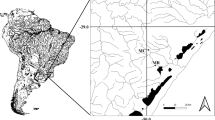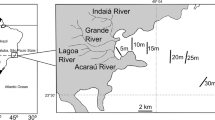Abstract
Catches of the spanner crab, Ranina ranina (Linnaeus, 1788), in southern Queensland, Australia in 1982 and 1983 showed a seasonal cycle, with peak catches from August to September. In most catches, males outnumbered females. Catches of both male and female spanner crabs declined in November and December, when a high proportion of females caught were ovigerous. Fish, echinoderms and polychaetes were the main food items. Closed-circuit time-lapse video recording was used to study the emergence behaviour of R. ranina in a 6 m-diameter tank. Spanner crabs in this tank were buried most of the time, emerging on average for only 1.7 h d-1. They emerged mainly between 16.00 and 24.00 hrs and, less often, between 01.00 and 15.00 hrs. Males remained emerged significantly longer than females. The duration of emergence of the females peaked before the spawning season, becoming shorter during the period when they were ovigerous. Temperature and emergence were negatively correlated. It is concluded that reproductive behaviour has a strong influence on catch composition of spanner crabs.
Similar content being viewed by others
Literature cited
Atkinson, R. J. A. and A. J. Parsons: Seasonal patterns of migration and locomotor rhythmicity in populations of Carcinus maenas. Neth. J. Sea Res. 7, 81–93 (1973)
Barnard, K. H.: South African decapod Crustacea. Ann. S. Afr. Mus. 38, 396–399 (1950)
Bourne, G. C.: A study in carcinology. J. Linn. Soc. (Zool.) 35, 25–78 (1922)
Broekhuysen, G. J.: On the development, growth and distribution of Carcinides maenas. Archs néerl. Zool. 2, 258–399 (1937)
Elner, R. J.: The influence of temperature, sex and chela size on the foraging strategy of the shore crab Carcinus maenas. Mar. Behav. Physiol. 7, 15–24 (1980)
Fielding, A. and S. R. Haley: Sex ratio, size at reproductive naturity, and reproduction of the Hawaiian Kona crab Ranina ranina (Linnaeus) (Brachyura, Gymnopleura, Raninidae). Pacif. Sci. 30, 131–145 (1976)
Hartnoll, R. G.: The biology of the burrowing crab, Corystes cassivelaunus. Bijdr. Dierk. 42, 139–155 (1972)
Howard, A. E.: The distribution and behaviour of ovigerous edible crabs Cancer pagurus and consequent sampling bias. J. Cons. int. Explor. Mer 40, 259–261 (1982)
Kanciruk, P. and W. F. Herrnkind: Preliminary investigations of the daily and seasonal locomotor activity rhythms of the spiny lobster, Panulirus argus. Mar. Behav. Physiol. 1, 351–359 (1973)
Klein Breteler, W. C. M.: Settlement, growth and production of the shore crab Carcinus maenas, on tidal flats in the Dutch Wadden Sea. Neth. J. Sea Res. 9, 243–254 (1976)
McLeese, D. W. and D. G. Wilder: The activity and catchability of the lobster Homarus americanus in relation to temperature. J. Fish. Res. Bd Can. 15, 1345–1354 (1958)
Morgan, G. R.: Aspects of the population dynamics of the western rock lobster Panulirus cygnus. II. Seasonal changes in the catchability coefficient. Aust. J. mar. Freshwat. Res. 25, 249–259 (1974)
Naylor, E.: Seasonal changes in a population of Carcinus maenas in the littoral zone. J. Anim. Ecol. 31, 601–609 (1962)
Naylor, E.: Temperature relationships of the locomotor rhythm of Carcinus. J. exp. Biol. 40, 669–679 (1963)
Paul, R. K. G.: Natural diet, feeding and predatory activity of the crabs Callinectes arcuatus and C. toxotes (Decapoda, Brachyura, Portunidae). Mar. Ecol. Prog. Ser. 6, 91–99 (1981)
Ropes, J. W.: The feeding habits of the green crab Carcinus maenas. Fishery Bull. Fish Wildl. Serv. U.S. 67, 183–203 (1968)
Williams, M. J.: Survey of fishing operations in Queensland in 1979, 34 pp. Brisbane, Australia: Queensland Fisheries Service, Department of Harbours and Marine 1980. (Qd Fish. Tech. Rep. No. 2)
Williams, M. J.: Natural food and feeding in the commercial sand crab Portunus pelagicus (Crustacea, Decapoda, Portunidae) in Moreton Bay. J. exp. mar. Biol. Ecol. 59, 165–176 (1982)
Williams, M. J. and B. J. Hill: Factors influencing pot catches and population estimates of the portunid crab Scylla serrata. Mar. Biol. 71, 187–192 (1982)
Author information
Authors and Affiliations
Additional information
Communicated by J. Mauchline, Oban
Rights and permissions
About this article
Cite this article
Skinner, D.G., Hill, B.J. Catch rate and emergence of male and female spanner crabs (Ranina ranina) in Australia. Marine Biology 91, 461–465 (1986). https://doi.org/10.1007/BF00392596
Accepted:
Issue Date:
DOI: https://doi.org/10.1007/BF00392596




